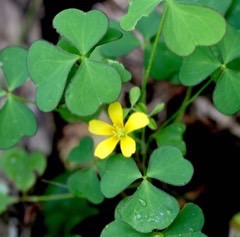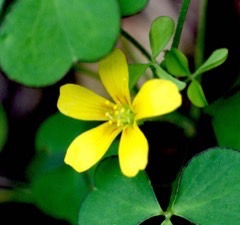 |
|
Paul Rothrock swbiodiversity.org |
 |
| Paul Rothrock swbiodiversity.org |
Translate this page:
Summary
Physical Characteristics

 Oxalis grandis is a ANNUAL/PERENNIAL growing to 0.2 m (0ft 8in) by 0.2 m (0ft 8in) at a fast rate.
Oxalis grandis is a ANNUAL/PERENNIAL growing to 0.2 m (0ft 8in) by 0.2 m (0ft 8in) at a fast rate.
See above for USDA hardiness. It is hardy to UK zone 6.
It is noted for attracting wildlife.
Suitable for: light (sandy), medium (loamy) and heavy (clay) soils and prefers well-drained soil. Suitable pH: mildly acid, neutral and basic (mildly alkaline) soils. It can grow in full shade (deep woodland) or semi-shade (light woodland). It prefers moist soil.
UK Hardiness Map
US Hardiness Map
Synonyms
O. recurva Trel. [Illegitimate]. Xanthoxalis grandis (Small) Small
Plant Habitats
Edible Uses
Edible Parts: Flowers Leaves
Edible Uses:
Leaves are tart [1-2]. Leaves - raw or cooked[2, 7, 12, 37]. A delicious lemony flavour, the leaves make a refreshing, thirst-quenching munch and are also added to salads, soups, sauces etc[183]. This leaf should be used in moderation[4, 5, 9, 76], see the notes above on toxicity. Flowers - raw. A decorative addition to salads[K].The plant can be toxic and only small amounts should be eaten. Large quantities may cause trembling, cramps, and staggering as in grazing animals.
References More on Edible Uses
Medicinal Uses
Plants For A Future can not take any responsibility for any adverse effects from the use of plants. Always seek advice from a professional before using a plant medicinally.
Some Oxalis species have medicinal properties but no information could be found for this species. For example Oxalis acetosella: The fresh or dried leaves are anodyne, antiscorbutic, astringent, diuretic, emmenagogue, expectorant, febrifuge, irritant and stomachic[4, 7, 9, 21]. A decoction is used in the treatment of fevers, both to quench the thirst and allay the fever[4]. Externally, the leaves are crushed and applied locally to dispel boils and abscesses, they also have an astringent affect on wounds[7]. When used internally, some caution is advised due to the oxalic acid content of the leaves[4], the plant is contra-indicated for people suffering from gastritis or a calculus condition[7].
References More on Medicinal Uses
The Bookshop: Edible Plant Books
Our Latest books on Perennial Plants For Food Forests and Permaculture Gardens in paperback or digital formats.

Edible Tropical Plants
Food Forest Plants for Hotter Conditions: 250+ Plants For Tropical Food Forests & Permaculture Gardens.
More

Edible Temperate Plants
Plants for Your Food Forest: 500 Plants for Temperate Food Forests & Permaculture Gardens.
More

More Books
PFAF have eight books available in paperback and digital formats. Browse the shop for more information.
Shop Now
Other Uses
The juice of the leaves removes iron mould stains from linen[6, 66, 115]. Plants can be grown as a ground cover in woodland or under the shade of shrubs[208].
Special Uses
Food Forest Ground Cover
References More on Other Uses
Cultivation details
Annual or perennial herb preferring shade to semi-shade and a mesic - moist to slightly dry soil. For polyculture design as well as the above-ground architecture (form - tree, shrub etc. and size shown above) information on the habit and root pattern is also useful and given here if available. The plant growth habit is a runner spreading indefinitely by rhizomes or stolons [1-2]. The root pattern is rhizomatous with underground stems sending roots and shoots along their length [1-2]. Bloom Color: Yellow. Bloom Time: May to Sep.
References Carbon Farming Information and Carbon Sequestration Information
Temperature Converter
Type a value in the Celsius field to convert the value to Fahrenheit:
Fahrenheit:
The PFAF Bookshop
Plants For A Future have a number of books available in paperback and digital form. Book titles include Edible Plants, Edible Perennials, Edible Trees,Edible Shrubs, Woodland Gardening, and Temperate Food Forest Plants. Our new book is Food Forest Plants For Hotter Conditions (Tropical and Sub-Tropical).
Shop Now
Plant Propagation
Seed - best sown as soon as it is ripe in a cold frame. Prick out the seedlings into individual pots when they are large enough to handle and plant them out in late spring or early summer. Division in spring. Very easy, larger divisions can be planted out direct into their permanent positions. We have found that it is better to pot up the smaller divisions and grow them on in light shade in a cold frame until they are well established before planting them out in late spring or early summer.
Other Names
If available other names are mentioned here
Great yellow wood-sorrel, Great yellow wood-sorrel, Large Yellow Wood-sorrel, Oxalis Sourgrass
Native Range
NORTHERN AMERICA: United States, Alabama, District of Columbia, Georgia, Indiana, Kentucky, Maryland, North Carolina, Ohio, Pennsylvania, South Carolina, Tennessee, Virginia, West Virginia,
Weed Potential
Right plant wrong place. We are currently updating this section.
Please note that a plant may be invasive in one area but may not in your area so it's worth checking.
None Known
Conservation Status
IUCN Red List of Threatened Plants Status :

Growth: S = slow M = medium F = fast. Soil: L = light (sandy) M = medium H = heavy (clay). pH: A = acid N = neutral B = basic (alkaline). Shade: F = full shade S = semi-shade N = no shade. Moisture: D = dry M = Moist We = wet Wa = water.
Now available:
Food Forest Plants for Mediterranean Conditions
350+ Perennial Plants For Mediterranean and Drier Food Forests and Permaculture Gardens.
[Paperback and eBook]
This is the third in Plants For A Future's series of plant guides for food forests tailored to
specific climate zones. Following volumes on temperate and tropical ecosystems, this book focuses
on species suited to Mediterranean conditions—regions with hot, dry summers and cool, wet winters,
often facing the added challenge of climate change.
Read More
Expert comment
Author
Small
Botanical References
Links / References
For a list of references used on this page please go here
Readers comment
| Add a comment |
|
If you have important information about this plant that may help other users please add a comment or link below. Only comments or links that are felt to be directly relevant to a plant will be included. If you think a comment/link or information contained on this page is inaccurate or misleading we would welcome your feedback at [email protected]. If you have questions about a plant please use the Forum on this website as we do not have the resources to answer questions ourselves.
* Please note: the comments by website users are not necessarily those held by PFAF and may give misleading or inaccurate information.
To leave a comment please Register or login here All comments need to be approved so will not appear immediately.
|
|